Accidents are usually the result of unsafe acts or conditions, or both. What specifically constitutes an unsafe act?
In the workplace, unsafe acts can include:
- Horseplay
- Not using personal protective equipment
- Running
- Using damaged tools
- Not lifting properly
- Violating safety rules
Unsafe conditions are physical hazards and can include:
- Missing machine guards
- Exposed electrical circuits
- Damaged equipment
- Slippery floors
- Improper storage of materials
- Lack of proper supervision
- Inadequate training
The good news is that there are steps you can take to eliminate the unsafe conditions and acts that often lead to accidents. Consider these simple practices to reinforce with your employees to help make the workplace safer:
- Follow all specific safety rules
- Report all unsafe acts or unsafe conditions to your supervisor
- Encourage fellow employees to work safely
- Check the condition of personal protective equipment and use the correct PPE for the specific hazard you are dealing with
- Ask for help if you need it
- Ask questions if you are not sure of the proper way to do something
- Lock out and tag all equipment before adjusting it or performing maintenance on it
- Inspect the condition of ladders before using them
- Don't use chemicals unless you have been specifically trained on the hazards and protective steps you need to follow to use them safely
- Keep your work area neat and clean to avoid trip hazards
- Use three-point contact when entering and exiting the cab of a truck
- Push, don't pull whenever possible
This list could go on, but you get the idea. Working in a safe manner is often just a matter of following some common sense guidelines and adhering to specific safety work rules.
Managers can have a big influence on the safety culture of a fleet. For starters they can create a job safety analysis (JSA). This is also referred to as a job hazard analysis and is a very effective means of helping reduce incidents, accidents and injuries in the workplace. It is an excellent tool to use during new employee orientations and trainings and can also assist with investigating “near misses” and actual accidents.
The JSA is a multi-step process. The first step is to break each job into a sequence of steps. Each of the steps should surround some major task. The task consists of a series of movements you need to look at within the basic task.
The next step is to identify hazards or potential hazards associated with each of the steps. It is very important to look at the entire environment to determine every conceivable hazard because each can and often leads to accidents and injuries.
Once you have identified the hazards, determine what actions you need to eliminate, control or minimize them. Each safe job procedure or action must correspond to the job steps and identified hazard.
Once you have completed the JSA, share the findings with your organization and review the actions employees need to take to ensure a safe, accident-free environment.



